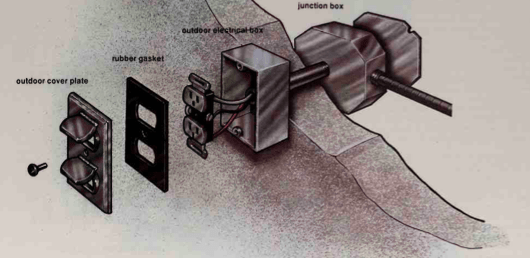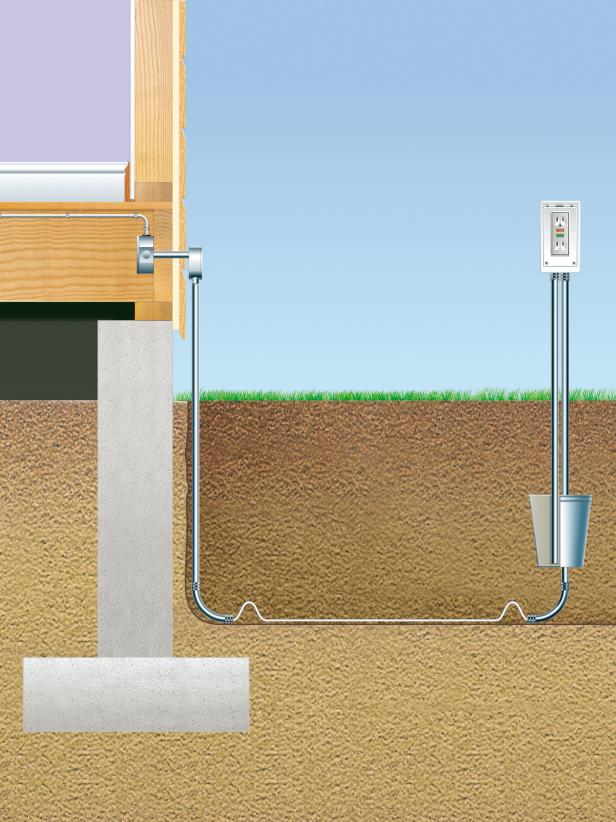Installing outdoor outlets is no more difficult than indoor wiring. However, there are extra safety regulations that must be followed.
We’re a nation equipped with electronic gizmos. While at one time the interior of the house was the domain of electricity, there’s an increasing need for power outdoors to handie our lawn mowers, lights and power tools
If you’re living in an older home without an electrical outlet outdoors, or if you want to add more outlets in your garden, outdoor wiring is simply a variation of the techniques used indoors. However, there are a few regulations unique to outdoor wiring that must be followed for safety considerations.
Outooor receptacles must be waterproof, with a spring-loaded cover sealing the outlets, to prevent moisture penetration when not in use. The perimeter of the outlet must be sealed against the weather by a caulking compound.
Although grounding and wiring connections are the same for outdoor outlets as they are for indoor ones, all outdoor outlets must have a ground fault interrupter to protect against shock from a defective outlet. And all fixtures and wiring must be approved for outdoor wiring. All cords plugged into an electrical outlet must be the three-prong grounded type.
A new outdoor line can be tapped into an existing wire, code permitting, or can be run directly from the service panel. It’s preferable to run your outdoor wiring on a new circuit, but you can tap into an existing general-purpose circuit that has a light electrical load on it. Remember that most electrical standards allow for a maximum of 12 outlets on a circuit. Always make sure the power is off before you work on a circuit.
When deciding on the placement of your new outlets, always consider the most advantageous location. Install an outlet on the side of the house to allow a cord to reach the front and back yards; put an outlet near the front door to handle Christmas lights; and, of course, outlets in the garage will provide power for block heaters or power tools. Freestanding outlets, those connected to posts in the ground, with wiring running underground to the service panel in your house, are most frequently located near patios or in gardens where you want some outdoor lighting.
Whichever outlet you decide to install, try to place it in an area that is protected from the elements. Don’t position it in a spot that constantly floods or drifts with snow, and try to keep it out of a direct wind path.
Plan the number of outlets you’ll need so you can avoid the use of extension cords, which can reduce the amount of current travelling to your electrical equipment. For safety considerations, install an indoor switch to turn your outdoor power on and off.
Number 12 or 14 gauge wire is used for outdoor wiring installations. The wire is run from the service panel to a junction box located on the inside wall at the spot where you’ll install the outdoor receptacle. Do not hook up the wire to the service panel until all wiring’s completed.
OUTDOOR WIRING

To determine where you might need outdoor electrical wiring, draw a sketch of your lot ana plot in patio receptacles or lights, garage receptacles, front sidewalk lighting or garden lighting.
Since most service panels are in the basement, you can run the wire along the ceiling joists either parallel to the joists, using cable clips to support the wire, or at right angles to the joists through predrilled holes. Locate your wire at least 7.5cm (3m) from the top and bottom of the joist, to avoid damage from any nails that might be driven into the floor above or the ceiling below at some point in the future Make sure your wiring isn’t touching any plumbing or heating pipes or any other wires that could create a hazardous situation Drill a hole through the foundation or through the wall surface above the foundation. If drilling through the wall surface, make sure you drill between studs and make sure there’s no wiring or plumbing in that spot.
The hole you drill needs to be large enough to contain the conduit through which the wire will run. The conduit should be long enough to attach to both the junction box inside the house and the receptacle on the outside.
The outlet box should be flush with the wall surface. Chip and cut away an area large enough to contain the box. Attach the conduit to the outlet box and the junction box inside the house, then caulk your outlet box in place.
You’re now ready to make your wiring connections to the receptacle and the service panel. Remember that many electrical codes require a permit and inspection for any type of house wiring. Before you make your final electrical hook-up, you’ll need to call an inspector
Installing a freestanding outlet follows similar hook-up techniques, but you need to bury the cable below the ground, and the conduit pipe holding the outlet will need to be supported in a cement footing.
Check your electrical code to see how deep the wiring needs to be buried. In some areas you may have to dig a trench 60cm (24in) deep.
Try to dig your trench in a straight line from the hole in your wall to the outlet to avoid conduit joints. Dig your trench with a flat spade so that you can save the sod.
The conduit pipe supporting the outlet will have to be buried in a gravel-based concrete footing. Slope the concrete away from the conduit to help water drainage.
Your wiring may have to run through a conduit underground, or you may be able to use plastic-sheathed wiring approved for underground applications. The type you use depends on your electrical code.
install the wiring, remembering the need for a ground fault interrupter, and refill your trench. The electrical hook-up is the same as for a wall-mounted outlet.
A wall-mounted light fixture is handled in the same manner as the wall receptacle, and a post-mounted light at the end of a driveway or sidewalk or in the garden uses the same techniques as a freestanding receptacle.
INSTALLING AN OUTDOOR RECEPTACLE

To install an outdoor receptacle, wires are placed through a hole in the wall close to the fuse box, or the wires are connected to the fuse box by way of a junction box attached to the inside wall right behind your new outlet.
